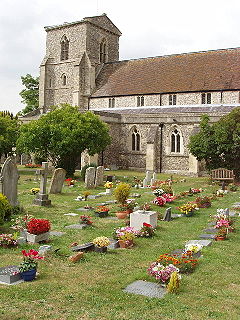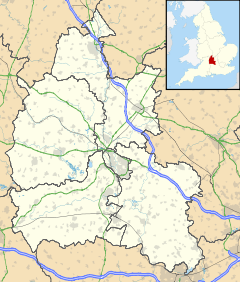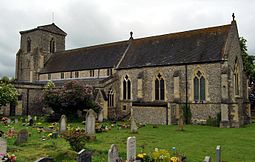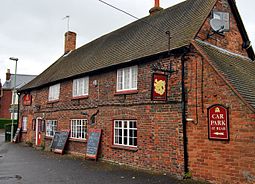- Chinnor
-
Coordinates: 51°42′07″N 0°54′40″W / 51.702°N 0.911°W
Chinnor 
St. Andrew's parish church
 Chinnor shown within Oxfordshire
Chinnor shown within OxfordshirePopulation 5,857 (parish, including Emmington, Henton & Oakley) (2001 census)[1] OS grid reference SP7500 Parish Chinnor District South Oxfordshire Shire county Oxfordshire Region South East Country England Sovereign state United Kingdom Post town Chinnor Postcode district OX39 Dialling code 01844 Police Thames Valley Fire Oxfordshire Ambulance South Central EU Parliament South East England UK Parliament Henley Website Chinnor Parish Council List of places: UK • England • Oxfordshire Chinnor is a village and civil parish in South Oxfordshire about 4 miles (6.4 km) southeast of Thame. The village is a Spring line settlement[2] on the Icknield Way below the Chiltern escarpment. Since 1932 the civil parish has included the village of Emmington.[2]
Chinnor formerly had a cement works and artisans supporting High Wycombe's furniture making industry, but in the 21st century is primarily a dormitory village for Thame, High Wycombe, Aylesbury and London.
Contents
Pre-history
The Icknield Way is a pre-Roman road. The site of an Iron Age settlement from perhaps the 4th century BC has been excavated on the Chiltern ridge in the southern part of the parish.[2] Traces of Romano-British occupation have ben found both on the same high ground and below on Icknield Way.[2]
A twin barrow on Icknield Way has been found to contain the weapons of a Saxon warrior that have been dated to the 6th century.[2] Chinnor's toponym may originally have meant the ora ("slope") of a man called Ceonna.[2] In subsequent centuries it was variously spelt Chennore and then Chynor.[citation needed]
Manor
There are records of Chinnor existing in the reign of King Edward the Confessor, when the manor was held by a Saxon royal servant called Lewin.[2] The Domesday Book of 1086 records Lewin as still holding Chinnor, but soon after it was in the hands of a member of the Norman de Vernon family.[2] However, in 1194 Walter de Vernon refused to help Prince John in France and all his lands were confiscated.[2]
In 1203 Chinnor and the neighbouring manor of Sydenham were granted to Saer de Quincy, whi in 1207 was created 1st Earl of Winchester.[2] However, in 1215 the Earl took part in the Baronial revolt against King John and his lands were confiscated.[2] In 1216 all of the Earl's lands were supposed to have been restored to him, but Chinnor was granted to Walter de Vernon's grandson Hugh de la Mere in exchange for two palfrey horses and a term of service at Wallingford Castle.[2] However, after the first Earl died in 1219 his son Roger de Quincy, 2nd Earl of Winchester successfully sued for possession of Chinnor and Sydenham.[2]
The 2nd Earl died in 1265 without a male heir. After the death of his widow Eleanor de Ferrers, the manor of Chinnor was divided between the Earl's three daughters Ellen, Lady Zouche, Elizabeth, Countess of Buchan and Margaret, Countess of Derby.[2] By 1279 Elizabeth's third of the manor had been transferred to Margaret.[2] This made the de Ferrers family feudal overlords of two thirds of Chinnor, which they retained until after 1517 when Walter Devereux, 9th Baron Ferrers of Chartley sold Chinnor to an Alderman of the City of London, Sir Stephen Jennings.[2]
Jennings immediately re-sold Chinnor to Richard Fermor of Easton Neston, Northamptonshire.[2] In 1607 Fermor's grandson Sir George Fermor and great-grandson Sir Hatton Fermor sold Chinnor to Sir John Dormer, MP for Aylesbury.[2] In 1667 Sir John's grandson Robert Dormer, also MP for Aylesbury, bought the Zouche manor that had been separate since the 13th century (see above).[2]
In 1739 Robert's grandson Lt. Gen. James Dormer, a member of the Kit-Cat Club, sold Chinnor to a William Huggins.[2] In 1761 Huggins left Chinnor to his daughter Jane and son-in-law Rev. James Musgrave, grandson of Sir Richard Musgrave, 2nd Baronet, of Hayton Castle.[2] Chinnor remained in the family of the Musgrave Baronets until the death of Sir William Augustus Musgrave, 10th Baronet in 1875, when it passed to his brother-in-law Aubrey Wenman Wykeham, who took the name Wykeham-Musgrave.[2] By then very little of the original lands remained with the manor.[2] His son Wenman Aubrey Wykeham-Musgrave inherited both Chinnor and Thame Park but in 1917 the estates were broken up and sold.[2]
Churches
Church of England
The earliest record of the Church of England parish church of Saint Andrew[3] is from 1160.[2] The nave was rebuilt in the 13th century,[2] when the present arcades of four and a half bays for first the north aisles and then the south aisle were built.[4] Building of the present tower began towards the end of the 13th century.[2] Early in the 14th century St. Andrew's was remodelled.[2] The chancel was entirely rebuilt,[4] the tower was made higher and the porch was built.[2] The aisles were widened, given new windows, and extended westwards to flank either side of the tower.[2][4] A rood screen was installed between the chancel and nave.[2] The chancel and high altar were dedicated in 1326, which may therefore have been the year that the remodelling was completed.[2] The high-pitched 13th century nave roof was replaced, probably later in the 14th century, with a Perpendicular Gothic clerestory and low-pitched roof.[2]
The architect Richard Pace built Saint Andrew's Rectory in 1813.[5]
St. Andrew's was restored in 1863-66. The plans were by the architect Edward Banks of Wolverhampton but were modified by the Oxford Diocesan architect G.E. Street and the Oxford architectural writer and publisher J.H. Parker.[2] The nave roof was restored to a high pitch and the chancel was raised above the nave.[2] Clayton and Bell restored the mediaeval stained glass and added a new east window.[2] The 14th century font was replaced with a new one of Caen stone.[2] The 14th century rood screen was reduced in height.[2] The chancel, nave and aisles were entirely refurnished.[2] However, in 1930 the original font was retrieved and reinstalled.[2]
In the south aisle is a carved recumbent effigy of a knight of about 1270[2] or 1300.[4] St. Andrew's has also one of the largest collections of monumental brasses in the country.[4] Most are 14th or 15th century but there are also later brasses commemorating a churchwarden (died 1899) and his wife, and two soldiers killed in the First World War.[2]
By 1558 St. Andrew's had a ring of four bells and a Sanctus bell.[2] In the succeeding century all were replaced and the ring was increased to five. William Knight II of Reading[6] cast the oldest bell in about 1586.[7] Further bells were cast by Henry Knight I in 1620,[7] Ellis Knight I in 1635,[7] and Henry Knight II in 1663.[7] A tenor bell was cast in 1651, but in 1864 it was recast as two smaller bells[2] increasing the ring to six. In 1965 John Taylor & Co of Loughborough cast a new Sanctus bell and in 1969 the same company cast a new treble and second bell to replace the two 1864 bells.[7]
St. Andrew's is now part of a single Benefice with the parishes of Sydenham, Aston Rowant and Crowell.[8]
Anabaptist
In the 18th century Chinnor had a small number of Anabaptists.[2] In 1732 a private house in Chinnor was licenced for Anabaptist worship, and in 1759 and 1768 six people from Chinnor worshipped at an Anabaptist meeting house in Princes Risborough.[2]
Congregational
The Congregationalist John Cennick (1718–1755) preached in Chinnor[2] but Chinnor Congregational Church[9] was not built until 1805.[2][10] It was enlarged in 1811 but suffered a schism in 1826, when a rival second chapel was built.[2] The schism had been healed by 1839, by which time the second chapel had been converted into the minister's manse.[2] By 1841 the minister had opened a British School.[2] A schoolroom was added to the chapel in 1884 and the chapel was restored in 1888.[2] In 1893 funds were raised to add an infants' classroom to the school but by the end of the year the school had closed.[2]
Methodist
The Methodist George Whitefield (1714–1770) preached in Chinnor and in 1753 two private houses were licenced for Methodist worship.[2] In 1759 Chinnor's Church of England rector reported that a third of the parish was Methodist.[2] By 1768 the Methodists had opened a small school in Chinnor.[2] In 1778 he reported that they were increasing but by 1784 the reported proportion had fallen to a quarter of the population.[2] By 1854 Chinnor had a Primitive Methodist chapel.[2] It was replaced by a new chapel built in 1873[10] which is now Chinnor Methodist Church.[11]
Social and economic history
By the early part of the 13th century there was a windmill on the Chiltern escarpment at Wainhill, about 1 mile (1.6 km) east of Chinnor village.[2] Chinnor had a watermill, but by 1279 it had been transferred to the neighbouring manor of Henton.[2] In 1336 the Ferrers manor at Chinnor (see above) had a windmill.[2] In 1789 a post mill was built on the west side of the village, off Whites Field. It was dismantled in 1965 and is currently being rebuilt by the Chinnor Windmill Restoration Society. It is unusual in having 3 crosstrees and 6 quarterbars.[12]
At the end of the 16th century Sir George Fermor (see above) enclosed some of the woods in the parish.[2] Attempts to enclose Chinnor's common lands were ruled illegal and reversed in 1761 and 1817.[2] Parliament passed an enclosure act for Chinnor in 1847 but the enclosure award to allocate the land was not implemented until 1854.[2]
On 18 June 1643 during the English Civil War a Royalist force of 1,800 men led by Prince Rupert arrived from Oxford, overcame the Parliamentarian garrisons at Postcombe and Chinnor and took 120 men prisoner. A pursuing Parliamentarian force intercepted them 7 miles (11 km) away near Chalgrove, but in the resulting Battle of Chalgrove Field the Royalists fought off their pursuers and returned with their prisoners to Oxford.
In the latter part of the 18th century a petition signed by the Rector and 13 tenant farmers complained that Chinnor had such a "multitude" of alehouses that they were "a check to industry and good order".[2] The petition claimed that the Chequers was a house of illfame and called for its licence not to be renewed.[2]
The 1851 Census recorded 268 lace-makers in Chinnor, including labourers' wives and 86 children.[2] Chinnor still has a lace group.[13]
Chinnor Cement and Lime Co. was founded in 1908 and became a public company in 1936.[2] It established a quarry in the Chiltern escarpment south of the village and a cement works. By 1975 it employed 160 men and was undergoing expansion to double its capacity.[2] It closed in 1989, its works have been demolished and in 2010–11 the site was redeveloped as a housing estate.[14]
Chinnor grew most quickly in the 1960s - from a population of 1,961 in the 1951 Census to 4,471 in the 1971 Census. Chinnor was then largely concentrated around the main rectangular street plan of Station Road, Lower Road, High Street, and Church Road. The hamlet of Oakley to the southwest was subsumed into the village around this time, when building along Oakley Road and the Mill Lane estate more than doubled the physical size of the village.
Schools
By 1803 Chinnor had a school of industry that taught lace-making and sewing.[2] In 1815 there were three schools teaching girls to make lace, which became an important local industry (see above).[2] There were four schools for boys but there was no Church of England school until the 1850s.[2]
In 1848 Magdalen College, Oxford voted to fund a Church of England school.[2] St. Andrew's Church of England Primary School[15] was designed by G.E. Street and building began in 1857.[2] Magdalen College provided further funds in 1859 and the landlord of the Crown Inn also gave funds.[2] The school at last opened in 1860.[2] In 1892 it was enlarged, again at Magdalen College's expense.[2] It became a voluntary controlled school in 1948 and taught children of all ages until a secondary modern school was opened at Thame.[2]
Chinnor now also has a community primary school.[16] Secondary school pupils are schooled in Thame or Watlington, and sixth formers in Henley or Thame.
Transport
The Watlington and Princes Risborough Railway between Princes Risborough and Watlington was built through the parish and opened in 1872. Chinnor railway station was opened to serve the village. The railway was independent until the Great Western Railway took it over in 1883. Sidings to serve Chinnor cement works were added in 1927. British Railways closed the railway through Chinnor to passengers in 1957 and to freight in 1961. The section between Princes Risborough and Chinnor remained open to serve Chinnor cement works until 1989.
Since 1994 Chinnor railway station has been the terminus of the Chinnor & Princes Risborough Railway heritage railway line. Steam trains are run on some weekends and bank holidays.
Chinnor has direct bus links with Thame, High Wycombe, and Princes Risborough railway station on the Chiltern Main Line.
Notable people
Rock musician Adam Clayton, bassist in the Irish band U2, was born in Chinnor in 1960.[17] Former BBC TV weatherman Bill Giles is a resident of the village.[18]
Annual Beer Festival
The Summer Chinnor Beer festival takes place this year on the 27th August at the playing fields. The beer festival raises money for the local youth of Chinnor. [19]
Amenities
Chinnor village currently has five public houses: The Black Boy, The Crown,[20] The Kings Head, The Red Lion and The Wheatsheaf.[21] Former pubs include The Bird in Hand (closed 2000) and The Royal Oak (closed 2011).[22] About 1.5 miles (2.4 km) south of the village at Spriggs Alley in the Chilterns is the Sir Charles Napier Inn[23] gastropub. Chinnor Football Club plays in the Hellenic Football League Division One East. Chinnor Cricket Club plays in Oxfordshire Cricket Association League Division 9.[24]
Chinnor has a public library,[25] a village hall and a Women's Institute.[26]
Gallery
References
- ^ "Area: Chinnor CP (Parish): Parish Headcounts". Neighbourhood Statistics. Office for National Statistics. http://neighbourhood.statistics.gov.uk/dissemination/LeadTableView.do?a=7&b=798634&c=Chinnor&d=16&e=15&g=480770&i=1001x1003x1004&o=1&m=0&r=1&s=1268443684501&enc=1&dsFamilyId=779. Retrieved 8 March 2010.
- ^ a b c d e f g h i j k l m n o p q r s t u v w x y z aa ab ac ad ae af ag ah ai aj ak al am an ao ap aq ar as at au av aw ax ay az ba bb bc bd be bf bg bh bi bj bk bl bm bn bo bp bq br bs bt bu bv bw bx by bz Lobel, 1964, pages 55-80
- ^ St. Andrew's parish church on A Church Near You
- ^ a b c d e Sherwood & Pevsner, 1974, page 535
- ^ Colvin, 1997, page 764
- ^ "Bell Founders". Dove's Guide for Church Bell Ringers. http://dove.cccbr.org.uk/founders.php. Retrieved 26 January 2011.
- ^ a b c d e "Chinnor S Andrew". Dove's Guide for Church Bell Ringers. http://dove.cccbr.org.uk/detail.php?searchString=Chinnor&Submit=+Go+&DoveID=CHINNOR. Retrieved 26 January 2011.
- ^ Archbishops' Council (January 2011). "Chinnor, Sydenham, Aston Rowant and Crowell". A Church Near You. Church of England. http://www.achurchnearyou.com/parish.php?p=270008/. Retrieved 26 January 2011.
- ^ Chinnor Congregational Church
- ^ a b Sherwood & Pevsner, 1974, page 536
- ^ Chinnor Methodist Church on www.findachurch.co.uk
- ^ Windmill World website: Chinnor Windmill, Oxfordshire
- ^ Chinnor Parish Council: Village Clubs/Organisations
- ^ "Old Kiln Lakes - Chinnor - Oxfordshire New Homes from £178,500". Find your perfect new home. Taylor Wimpey. http://www.taylorwimpey.co.uk/newhomes/Oxfordshire/OldKilnLakes/. Retrieved 4 February 2011.
- ^ St. Andrew's Church of England Primary School
- ^ Mill Lane Community Primary School
- ^ "Adam Clayton Biography". atu2.com. http://www.atu2.com/band/adam/. Retrieved 2010-12-28.
- ^ "Sunny Outlook for Bill". bucksfreepress.co.uk. http://www.bucksfreepress.co.uk/leisure/1459174.sunny_outlook_for_bill/. Retrieved 2011-07-13.
- ^ Bird, Steve. [www.chinnorbeerfest.org.uk "Mr"]. www.chinnorbeerfest.org.uk. Retrieved 22 May 2011.
- ^ Welcome to The Crown, Chinnor
- ^ "Pubs in Chinnor". beerintheevening.com. http://www.beerintheevening.com/pubs/results.shtml/el/Chinnor%3BOxfordshire/. Retrieved 2011-07-13.
- ^ "Chinnor's Closed Pubs". closedpubs.co.uk. http://www.closedpubs.co.uk/oxfordshire/chinnor.html. Retrieved 2011-09-20.
- ^ The Sir Charles Napier
- ^ Oxfordshire Cricket Association 2011
- ^ "Chinnor Library". Libraries. Oxfordshire County Council. http://www.oxfordshire.gov.uk/wps/portal/publicsite/councilservices?WCM_GLOBAL_CONTEXT=http://apps.oxfordshire.gov.uk/wps/wcm/connect/occ/Internet/Council+Services/Leisure+and+culture/Libraries/Your+local+library/LC+-+L+-+YLL+-+Chinnor. Retrieved 4 February 2011.
- ^ Oxfordshire Federation of Women's Institutes
Sources
- Colvin, H.M. (1997). A Biographical Dictionary of British Architects, 1600-1840. New Haven: Yale University Press. p. 764. ISBN 0-300-07207-4.
- Lobel, Mary D, ed (1964). A History of the County of Oxford: Volume 8: Lewknor and Pyrton Hundreds. Victoria County History. pp. 55–80.
- Oppitz, Leslie (2000). Lost Railways of the Chilterns. Newbury: Countryside Books. pp. 20–23. ISBN 1 85306 643 5.
- Sherwood, Jennifer; Pevsner, Nikolaus (1974). Oxfordshire. The Buildings of England. Harmondsworth: Penguin Books. pp. 534–536. ISBN 0 14 071045 0.
External links
 Media related to Chinnor at Wikimedia CommonsCategories:
Media related to Chinnor at Wikimedia CommonsCategories:- Villages in Oxfordshire
- Civil parishes in Oxfordshire
Wikimedia Foundation. 2010.









